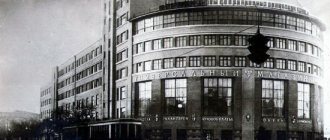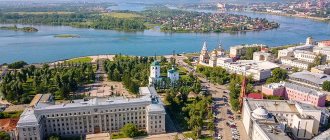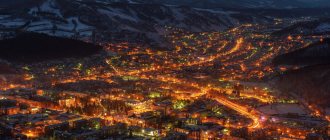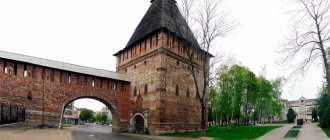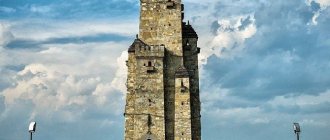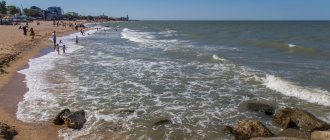What is Kalitva? Surprisingly, toponymists, who seem to know the answers to all questions, did not think about the meaning of this word until the forties. And only M. Makarov, commenting on Mr. Linde’s dictionary, noted: the word probably consists of two “Russianized” derivatives: kolo (about) and Litva.
Indeed, in a city with this name one can still hear words that are clearly of Lithuanian origin. In the south of Russia there is even the city of Belaya Kalitva. The Rostov region, the map of which reflects the diversity of nationalities living here, is proud of this small city, but with a glorious history.
A little history
More than a million people live in the territory called the Rostov region. Belaya Kalitva, which received city status only in 1958, is far from the first place in terms of population. But there are unique monuments here, one of which is known throughout Russia. This is the only monument in the world to the heroes of the Tale of Igor's Campaign. Installed in 1970, it has become one of the pearls of the urban settlement. The entire Rostov region is proud of this monument. Belaya Kalitva is also known for other literary compositions. Sholokhov’s Aksinya and Grandfather Shchukar, the Three Bears from a Russian fairy tale, and other small sculptural forms have long “lived” in the city. Sculptures are one of the main attractions of Belaya Kalitva. The smaller ones decorate lawns and flower beds. The larger ones are installed in gardens and parks. People make dates around them and make marriage proposals. Sculptures are an important part of city life.
However, the Rostov region is known not only for its literary monuments. Belaya Kalitva is also the battle of the Russians with the Polovtsians in 1185, which Boyan sang. This is the history of the Cossacks, directly related to the formation of the city. This is a revolution and a civil war (this is where Voroshilov’s headquarters was located). This is the Great Patriotic War. For six months the city was occupied by the Nazis, but managed to fully recover and heal its wounds. However, the city of Belaya Kalitva in the Rostov region is famous not only for its history.
Kalitva today
The first thing that catches the eye of visitors today is the scaffolding of new buildings. The city is gradually moving deeper into the steppe, turning green spaces into cozy residential areas. Like the entire Rostov region, Belaya Kalitva participates in several housing construction programs. However, the growing modern areas harmonize well with the “old city”.
The residents of Belokalitvina are very fond of their park, founded in the 19th century. Today it bears the name of V. Mayakovsky, and its architecture reflects the entire history of the city. The park has themed corners and attractions, a beach on the banks of the Donets and a modern embankment. With the same love, residents treat Karaul Mountain, which is the highest place in the city, Maidan, on which stands the revived Vvedensky Church, a monument to victims of repression, “Horses” rushing into the steppe (sculpture by S.P. Kalchenko). You can talk about the city for a long time. It is one of the most beautiful places for which the Rostov region is so famous. Belaya Kalitva... It’s worth coming here once and then again and again with pleasure returning to the hospitable city.
The settlement is located on the banks of the Northern Donets River, 168 km from Rostov-on-Don. The total area of the urban settlement is 165 square kilometers.
General data and historical facts
Peter I in 1703 ordered the Cossacks to settle the place on the Belaya Kalitva River. The year of this decree became the date of foundation of the village of Ust-Belocalitvenskaya, which was divided into 4 parts: Nizovka, Zayarovka, Maidan, Bugor.
In September 1937, the village of Ust-Belocalitvenskaya was included in the Rostov region. From July 1942 to January 1943, the settlement was occupied by German troops. During the war, 30 soldiers and lieutenant A. Ataev accomplished a feat. They took the height and held it for more than a day, fighting off enemy forces that were many times superior.
In 1958, the settlement became a city, in 1959 it became a regional center, and in 1988 the Belokalitvinsky district was formed.
In January 2006, the city was transformed into an independent municipal entity. The main enterprise of the city is Alcoa Metallurg Rus CJSC, founded in 1941. This enterprise took part in the development of the Ruslan project aircraft and the Buran spacecraft.
Nowadays, the following products are produced in the city: aluminum products, profiles, hardware, bricks, cornices, reinforced concrete, cardboard, personal protective equipment, flour products, meat.
The youth. Why does she want to leave town
Almost 95% of young people aged 18-25 want to leave Belaya Kalitva. Let it be Rostov-on-Don, Krasnodar or even Novocherkassk.
This is largely due to educational activities. To get a higher education, you need to leave the city, since there are no higher educational institutions in Belaya Kalitva. We have only three main educational institutions: BGIT, BMT and school No. 66.
Even if a teenager leaves after 9th grade and graduates from a municipal institution, he wants to leave the city due to the small number of jobs and lack of stable wages.
Fortunately, school graduates have a wide choice when entering cities: Rostov-on-Don, Novocherkassk, Kamensk-Shakhtinsky, Millerovo. Various institutes, universities, technical schools, and colleges located there will be able to provide a very good education for later life and earning money.
Attractions
1.Cossack cross
- wooden cross decorated with carvings. At all times, the Don Cossacks worshiped this monument. There is a horse next to the cross. It symbolizes a horse that sometimes returned home without its owner.
2.Red Bridge
- an old bridge that connects the banks of the Seversky Donets River. The building is located at the entrance to the city.
3.Mountains "Two Sisters"
- a beautiful natural attraction, which is located 8 km from the city. Two twin mountains are located on the right bank of the Seversky Donets River.
4.Historical center Maidan
— there are old buildings, commercial facades, and a chapel here. This center is under special control by the city administration.
5.Monument to the “First Teacher”
— the monument is located near one of the oldest schools in the city. The sculpture of a teacher and a first-grader is made of durable concrete with a metallic composition.
Renovation of the Sports Palace
I would like to talk on a separate topic about the current Metallurg Sports Palace, built in 1980, back in Soviet times. It received this name due to the fact that it was built by the team of the Alprof Metallurgical Plant.
The palace functioned stably until 2015, but due to a long lack of repairs, the roof was damaged.
The repairs were estimated at 33 million 250 thousand rubles and they promised to renovate the building by 2022, but this did not happen. It’s already 2018, money from the regional budget is promised at every meeting, but funding cannot be achieved.
Where do the trainings take place?
Children, teenagers and adults exercise at the stadium in the warm season, but in winter everything becomes much worse. The sub-zero temperature does not allow exercising outside, and the Sports Palace is in disrepair.
So we have to negotiate with the directors of schools, technical schools, colleges about providing their gyms for training. Of course, this is very inconvenient for many children.
The approximate distance from the city to the 103rd school is 3-4 kilometers. Buses run on schedule - once every hour and a half, so, in most cases, you have to walk through all the alleys of our city.
Sports Palace "Metallurg".
In the photo you can see that the windows are wooden, which means that in winter it was cold in the room on the second floor. If the first floor warmed up at least somehow, then the second floor was very cool. Residents hope that this issue will be resolved soon.
Transport
There is a railway station of the same name in the city. City transport is represented by several bus routes.
Information about the city of Belaya Kalitva, Rostov region
In 1941, the village of Ust-Belokalitvinskaya began to be called the village of Belaya Kalitva, in 1958 the village received the status of a city, and in 1959 - a regional center. Since 1988, the city and the Belokalitvinsky district (76 settlements) have been a single territorial unit with a common “administrative management”. The city and district are located in the central part of the Rostov region, on the eastern tip of the Donetsk Ridge, on the banks of the largest tributary of the Don - the Seversky Donets. The city itself stands at the mouth of the Kalitva and Likhaya rivers flowing into the Donets. There are a total of 6 rivers, 8 rivulets, and 20 streams in the area. The right rocky bank of the Seversky Donets in the vicinity of the city has a highest elevation of 148.8 m above sea level.
The length of the North Caucasian Railway across the territory is 95 km with the stations “Boguraevo”, “Belaya Kalitva”, “Grachi”. The city bus station, located on the Rostov-Volgograd highway, serves 20 intercity routes and 39 transit routes, including those to Ukraine. Summer intercity routes along the Donets have been cancelled, only local ones operate. The local airline airport serves agricultural aviation.
Territory area 2650 sq. km, length from north to south is 150 km. The population as of January 1, 2003 was 113.7 thousand people, of which 82.1 thousand were urban residents, 31.6 were rural residents.
In 1703, a group of Cossacks petitioned military chieftain Ekim Filipyev for permission to settle a new town at the mouth of the Belaya Kalitva River. This date is considered official, although back in 1515, the ambassador of Vasily III Korobov, in his report, mentioned the people he saw at the mouth of the Kalitva. The embassy's route passed along one of the oldest caravan routes through the rifts of the Donets, which shallowed in summer. Excavations in 2002 (Don Archaeological Society, R.V. Prokofiev) indicate that there was an ancient Russian settlement on the territory of the 12-13th century. In 1675 -1683, Old Believers settled in the area, away from the caravan routes.
The entire pre-revolutionary history of Belaya Kalitva is connected with the Cossacks. Among the outstanding military leaders of Belokalitvintsy, Pyotr Ivanovich Pavlov is famous. For the brilliantly organized fortifications in the defense of Sevastopol in 1855, Alexander III personally awarded him the Order of St. Anna 1st degree. During the same war, Colonel Ivan Ivanovich Kostin became famous for his bravery. Major General Viktor Danilovich Popov graduated from service as manager of the Ataman's office. Lieutenant General Nikolai Ivanovich Lazarev distinguished himself in the Russian-Turkish War of 1877 -1878, was awarded gold and silver weapons, and a number of Russian and foreign orders.
Since 1804, stone mining (sandstone, limestone) began in Ust-Belokalitvinskaya; 1827 - coal. The beginning of revolutionary activity in the Ust-Belokalitvinsk mining villages was laid by E.A. Shchadenko and S.S. Turlo.
In May 1918, the headquarters of the 5th and 3rd Ukrainian Red Armies retreating to Tsaritsyn under the command of K.E. was located in Ust-Belokalitvinskaya for several days. Voroshilov. The historic meeting of the Red Army commanders N.A. took place here. Rudneva, A.Ya. Parkhomenko, E.A. Shchadenko and Artem. At the same time, the expedition of F.G. arrived in the village. Podtelkova and M.V. Krivoshlykova.
During the Great Patriotic War, Cossack valor made itself felt: three Belokalitvinians became full holders of the Order of Soldier's Glory, fifteen became Heroes of the Soviet Union. Belaya Kalitva was under occupation for six months. Her liberation took place in the area of the Battle of Stalingrad. In the Belaya Kalitva region there are active Orthodox churches: one from the 18th century (rebuilt) and three from the 19th century. Two churches are being restored and two new ones are being built. On one of the hills located within the city, in 1970, the only monument in Russia to “The Tale of Igor’s Campaign” was erected. There is a municipal historical and local history museum.
The cultural life of the city and region is represented by three music schools and an art school with branches, 44 libraries and 43 club institutions, 195 amateur art groups. Since the work of the famous folklorist, our fellow countryman Professor AM Listopadov (1873-1949), ancient songs have continued to be collected here. A developed sports complex: a Sports Palace with two swimming pools, 98 gyms, two rowing bases, a chess club, four sports schools, including the Olympic reserve.
Four world champions in kayaking and canoeing (1995-2002) and two world champions in athletics (1998, 2003) were raised in Belaya Kalitva. The All-Russian competition named after Hero of the Soviet Union B.I. is held at the rowing base. Bykova. The city-forming enterprise is the metallurgical plant, founded in 1941. In 1969, the plant was the first in the world to master the casting of ingots into an electromagnetic crystallizer (the invention was patented in 17 countries around the world). The specialists became laureates of the USSR State Prize. The plant was the first in the USSR to master the production of Teflon-coated cookware. Participated in projects for the construction of the Ruslan aircraft and the Buran spacecraft, and received the Government Prize No. 11997 in the field of quality.
Belaya Kalitva is a small town in the Rostov region, located on the banks of two rivers, Seversky Donets and Kalitva. Belaya Kalitva can be called one of the monuments of the Cossacks on the Don. ( 78 photos
)
Despite the small number of residents, just over 40 thousand, the city is quite large, relatively speaking, where approximately the same number of people live. Kalitva is located 170 km from Rostov-on-Don.
In a picturesque place, with beautiful nature, on the banks of the Seversky Donets River, which is the largest tributary. By the way, on the same Donets there is a small but beautiful village.
The city was founded in the 18th century as a Cossack village. Then, in 1703, Peter 1 granted the request of the Cossacks to create a farm. But archaeological evidence suggests that the first settlements were formed here already in the 4th century BC. e.
City square, always hungry pigeons do not let children get bored.
The village received city status in 1958, but the entire culture and atmosphere of the Cossack flavor has been preserved to this day. During the Great Patriotic War, the city was captured, and during its liberation, near Belaya Kalitva, the feat of Panfilov’s men was repeated. The Red Army soldiers captured and held the heights.
Lenin Square against the backdrop of the Palace of Culture - Belaya Kalitva photo
The city-forming enterprise is an aluminum smelter, which produces various types of goods, from dishes to load-bearing structures. There are also other types of enterprises, a large number of individual entrepreneurs. In general, it feels like there is money in the city.
There are a large number of monuments in the city. Mainly Cossack themed, many of them are inspired by the years of the Great Patriotic War. Two tanks were installed, one of them at the monument to fallen soldiers with an eternal flame.
Sports are well developed in the city. There is a sports complex (now closed for renovation), a chess club, a rowing base, 4 sports schools, laser tag, paintball, etc.
Belaya Kalitva city photos
Despite the fact that the population in the city is declining, in general Kalitva continues to develop. This is how an entire microdistrict of nine-story buildings was built.
It is worth noting that children in the chess club study for free.
Chess club in Belaya Kalitva
Belaya Kalitva welcomes you with its comfort and unique flavor. Most of the buildings are low; you can hardly find old buildings above 3 floors here. There are many wooden Cossack houses, divided into “bottoms” and “tops”.
The city is rich not only in man-made monuments but also in natural ones. For example, the famous “Two Sisters” mountains. Two completely identical hills are located on the banks of the river, representing a beautiful natural monument.
There are many legends and stories around the mountains. They say that Vanga mentioned them and advised walking barefoot.
Beautiful nature in Belaya Kalitva
People in Kalitva are friendly and kind, easy to communicate with, but educated. You might be surprised when, on public transport, a woman of about 60 years old, with kind eyes, tries to figure out which center you need to go to, while her scream can be heard throughout the entire bus. Out of habit, it may seem that she is angry, but she is not, it’s just a way of communicating, they talk loudly.
And in the vicinity of Kalitva there is an almost abandoned farmstead called Dyadin, it is interesting because famous people, scientists and heroes of the Soviet Union grew up here, but the main thing is that there is a temple here.
There are many stories surrounding the temple. And during the Great Patriotic War, a shell hit it, but practically did not destroy the temple. It has been restored for many years.
Temple in the Dyadin farm
Stunningly beautiful place.
There are several parks in the city, one of them is an amusement park.
Center of Kalitva in the Soviet years.
Kalitva River
In one of the villages of Belaya Kalitva, the traditional annual holiday “Kayal Readings” takes place. At which, in addition to the festive concert, a reconstructed battle between the Russians and the Polovtsians takes place. This battle is sung in “The Tale of Igor’s Campaign.” Historians believe that the battle took place right here, in the interfluve of the Kalitva and Bystraya rivers.
Winter in Kalitva is always spent skating. In several places on the river you can find hockey fields and play with a friendly group.
Another natural monument of Kalitva is a pine forest. Centuries-old pine trees provide an opportunity to take a useful walk before bed and breathe in fresh air filled with the scent of pine.
The city of Belaya Kalitva is located on the territory of the state (country) Russia, which in turn is located on the territory of the continent of Europe.
Negative aspects of my city
To be honest, there are very few places here where people can go and really relax, regardless of their age. The only close place can be considered the square, which is located near the Palace of Culture named after. Chkalova.
Where to relax
In almost every yard you can see such a swing.
A more distant attraction is the Prospekt cinema, in the village of Zarechny, but just so you understand, the distance from the city to the cinema is about twenty kilometers. In “Prospect” there is a cafe “Baggies”, which has an entertainment area for children under 10 years old, but the services there are quite expensive.
Despite the considerable distance, people go there on weekends with their families to relax, eat, or just watch their favorite movie or cartoon.
Metallurgical plant
It is impossible not to mention the Alprof Metallurgical Plant. Although it specializes mainly in aluminum and aluminum parts, zinc and lead are also used in metal alloys.
Every person with basic knowledge of chemistry understands that these elements are strong aggressors of cancerous tumors. After all, where do the vapors of these alloys emit? Of course, into the atmosphere whose air the city residents breathe.
Our roads and attitude to sports
I believe that throughout Russia the problem of roads remains relevant, but it is better not to talk about the roads of Belaya Kalitva at all. You won’t be able to drive even ten meters before there is either a bump or a bump.
